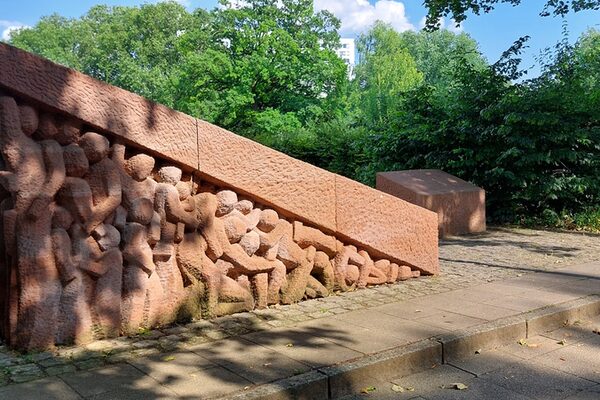Memorial to the deported and murdered Sinti and Roma
The memorial to the deported and murdered Sinti and Roma is located in Bahnhofstraße in the Reisinger-Anlagen. It was inaugurated on December 5, 1992, making it the first memorial in Germany to commemorate the persecution of the Sinti and Roma minority.
Persecution of the Sinti and Roma
At the beginning of the Nazi dictatorship, there were around 26,000 Sinti and Roma living in Germany. Most of them were German citizens. The Nazi state declared them to be a "non-European alien race" and persecuted them mercilessly. From 1935, the Sinti and Roma were not allowed to marry a partner who came from the "Aryan majority population". In 1937, the minority as a whole was declared "asocial", with the consequence that they could be taken into preventive detention at any time and sent to a concentration camp. The "Reich Central Office for Combating Gypsyism", established in 1938, and the "Racial Hygiene and Population Biology Research Centre in the Reich Health Office" prepared the organizational aspects of the genocide of the European Sinti and Roma. In the so-called Himmler-Thirack Agreement of 17 September 1942, the Reichsführer SS and the Reich Minister of Justice stipulated that "asocial elements" from the penal system were to be handed over to the Reichsführer SS for extermination through labor. This included Jews, so-called Gypsies, Russians and Ukrainians. On December 16, 1942, Heinrich Himmler ordered the deportation of the Sinti and Roma to the Auschwitz extermination camp.
On October 17, 1939, the so-called "Festsetzungserlass" was issued, which prohibited Sinti and Roma from leaving their place of residence or stay without police permission. Failure to comply was punishable by imprisonment in a concentration camp. In the course of this, a list of 119 names and addresses was compiled by the Wiesbaden criminal investigation department. On the basis of this list, the people living in Wiesbaden and the surrounding area were arrested by the police authorities on March 8, 1943 and rounded up in the synagogue or the Jewish community center in Friedrichstraße. They were then taken via Bahnhofstraße to Wiesbaden's main railway station and deported from there via Frankfurt to Auschwitz. More than half of them were murdered there, including around 40 children, most of whom were deported to the Auschwitz-Birkenau extermination camp together with their families on March 8, 1943. It is estimated that the National Socialists murdered tens of thousands of Sinti and Roma children.
The marginalization and persecution of the Sinti and Roma did not end in 1945. Police authorities and state criminal investigation offices continued to register people in "Landfahrerkarteien". "Hereditary biology research" on the minority, which had begun during the Nazi era, was continued by the same scientists in federal and state offices in the Federal Republic. Benefits under the "Federal Compensation Act" were often refused for Sinti and Roma. The authorities often cited the reasons for internment noted on the concentration camp identification cards as the supposed justification. Their persecution was therefore not racist, but the prisoners were arrested as criminals.
Erection of the memorial
The erection of the memorial was decided by the Wiesbaden City Council on May 21, 1992, after fierce political controversy. The memorial was presented to the citizens on December 5. The inauguration was preceded by a memorial walk in which the participants, including Wiesbaden's then Lord Mayor Achim Exner, took the same route through Bahnhofstrasse that the Wiesbaden Sinti and Roma had to take when they were deported.
Idea and design
The memorial consists of a large three-part sandstone block. It shows a group of men, women and children - crushed under a heavy burden - on their way to their doom. It was designed by Josef and Eugen Reinhardt from the Sinti workshop in Albersweiler (Palatinate). It was commissioned by the Cultural Office of the state capital Wiesbaden.
Literature
Udo Engbring-Romang: Wiesbaden. Auschwitz. On the persecution of the Sinti in Wiesbaden. Publisher: Adam Strauß; Association of German Sinti and Roma, Regional Association of Hesse. Frankfurt: Brandes & Apsel 1997 ("Cornea on the soul". Writings of the Association of German Sinti and Roma, Regional Association of Hesse. Volume 2)
SiRo app of the Association of German Sinti & Roma, State Association of Hesse: In 2023, the State Association of Sinti and Roma in Hesse published an app that presents, among other things, a city tour on the history of the Sinti and Roma in Wiesbaden. The app provides comprehensive information on the history and persecution of the German minority.
Further information
City archive
Address
65197 Wiesbaden
Postal address
65029 Wiesbaden
Arrival
Notes on public transport
Public transportation: Bus stop Kleinfeldchen/Stadtarchiv, bus lines 4, 17, 23, 24 and 27 and bus stop Künstlerviertel/Stadtarchiv, bus line 18.
Telephone
- +49 611 313022
- +49 611 313977
Opening hours
Opening hours of the reading room:
- Monday: 9 a.m. to 12 p.m.
- Tuesday: 9 am to 4 pm
- Wednesday: 9 am to 6 pm
- Thursday: 12 to 16 o'clock
- Friday: closed
